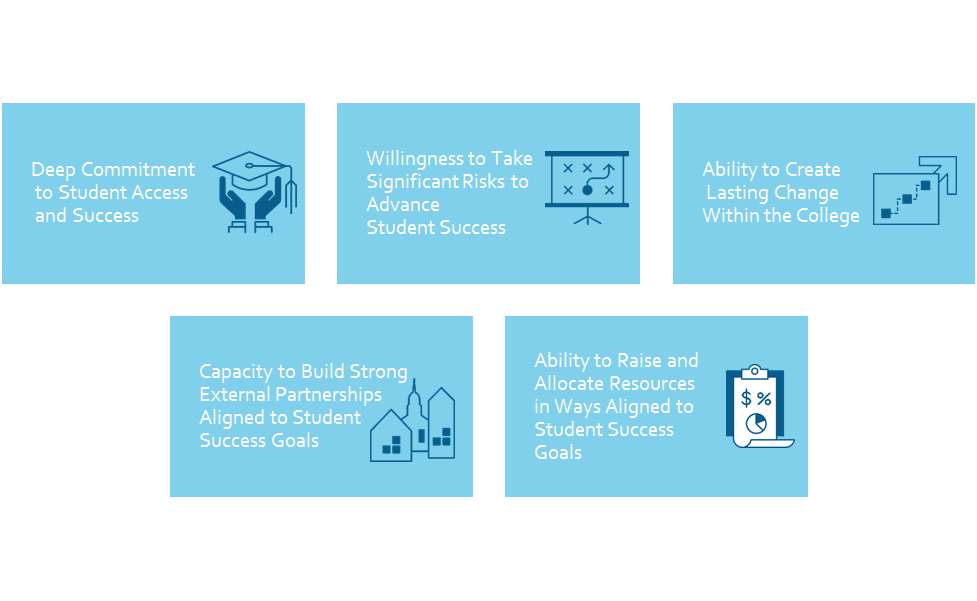Learning Objectives & Outcomes
After completing this module, participants will be able to:
- Describe the five qualities of exceptional community college leaders as defined by the Aspen Institute and Achieving the Dream.
- Understand the relevance of each leadership quality to leadership in practice.
- Draw connections between the five leadership qualities and other relevant ways of thinking about leadership.
- Reflect on participants’ personal leadership capacities in relation to each defined leadership quality, and define action steps to encourage growth in areas identified for development.
Module Overview
Community college leadership matters. Just to keep a community college’s doors open, presidents must ensure that all the systems and people are in place to attract, register, and process aid for students; devise and deliver curriculum for programs and courses; plan and deliver tutoring, advising, and other student supports; hire, manage, and evaluate faculty and staff (including handling contract negotiations); erect, renovate, and maintain buildings and grounds; raise revenue from tuition, government, foundations, corporations, and other donors; provide effective technology; conduct institutional research; and more. While presidents do only a small portion of that work themselves, they ultimately hold responsibility for all of it. All this essential internal work—not to mention work related to external partnerships and relationships—requires more hours than anyone would consider “full –time.”
But exceptional presidents—those whose institutions achieve high and improving levels of student success—find time to do more than keep the doors open. They have a passion for student access and success and a vision for how to lead. Consider the following from Dr. Sandy Shugart, president of Valencia College, winner of the 2011 Aspen Prize:
When I was first hired as a community college president at the age of 34, I approached a seasoned president, the one I admired most among the many fine presidents in our system, and asked for counsel. He said, “Remember that every presidency means something; you’ll want to be the one who decides what yours will mean.” Sometimes circumstances dictate what a presidency will mean. But much more often, we simply fail to be this intentional about the impact we really want to make on our colleges and the people and communities we serve. It has taken me a while to live into the advice my mentor gave me, but it is very clear to me these past fifteen years or so that achieving extraordinary results with ordinary students is what I want my work to mean.
Shugart’s perspective is echoed in current policy conversations. No longer is it enough for community colleges to enroll students in traditional pathways that are well operated and funded. Today, policymakers expect that community colleges will deliver “extraordinary results.”
Against this changing set of expectations, this module invites learners to reflect on what their leadership will mean and what role student success and learning will play in that narrative. As a structure for that exploration, the module presents key characteristics of leaders whose institutions have generated significant improvements in student learning and success. Specifically, in 2013, the Aspen Institute and Achieving the Dream researched the qualities of presidents who were, at the time, leading community colleges that had achieved high and improving levels of student success. Reflected in the 2013 report Crisis and Opportunity: Aligning the Community College Presidency with Student Success, the following five attributes were identified as particularly important among transformational leaders:
- Deep commitment to student access and success
- Willingness to undertake significant risks to advance student success
- Ability to create lasting change within the college
- Capacity to build strong external partnerships aligned to student success goals
- Ability to raise and allocate resources in ways aligned to student success goals
In the introduction to “Transformational Leadership in Organizational Culture,” Bernard Bass describes the difference between transactional and transformational leadership in the following way: “Transactional leaders work within their organizational cultures following existing rules, procedures and norms; transformational leaders change their culture by first understanding it and then realigning the organization’s cultures with a new vision and a revision of its shared assumptions, values, and norms.” While transactional leadership is a valuable part of college leadership, this module focuses on the role of transformational leadership, exploring its attributes and providing learners with the opportunity to reflect on how these attributes could be applied to improve student outcomes in their current or future community college campus.
Preparation
Pre-reading
- American Association of Community Colleges. (2005). Competencies for community college leaders. Retrieved from http://www.aacc.nche.edu/newsevents/Events/leadershipsuite/Documents/AACC_Core_Competencies_web.pdf
- Aspen Institute & Achieving the Dream. (2013). Crisis and opportunity: Aligning the community college presidency with student success. Retrieved from http://www.aspeninstitute.org/publications/crisis-opportunity-aligning-community-college-presidency-student-success
- Kotter, J. P. (2007, January). Leading change: Why transformation efforts fail. Harvard Business Review, 92-107.
Module Outline
- Kickoff Activities
- Leadership Qualities
- Four Corners
- Quality 1: Deep Commitment to Student Access and Success
- Key Learning
- Group Application Activity: Operationalize
- Group Discussion: Connect
- Independent Activity: Reflect and Plan for Action
- Quality 2: Willingness to Take Strategic Risks to Advance Student Success
- Key Learning
- Group Application Activity: Operationalize
- Group Discussion: Connect
- Independent Activity: Reflect and Plan for Action
- Quality 3: Ability to Create Lasting Change Within the College
- Key Learning
- Group Application Activity: Operationalize
- Group Discussion: Connect
- Independent Activity: Reflect and Plan for Action
- Quality 4: Capacity to Build Strong External Partnerships Aligned to Student Success Goals
- Key Learning
- Group Activity: Operationalize
- Group Discussion: Connect
- Independent Activity: Reflect and Plan for Action
- Quality 5: Ability to Raise and Allocate Resources in Ways Aligned to Student Success Goals
- Key Learning
- Group Application Activity: Operationalize
- Connect
- Independent Activity: Reflect and Plan for Action
- Bringing It All Together
- Group Application Activity: Strategies for Leadership Development

